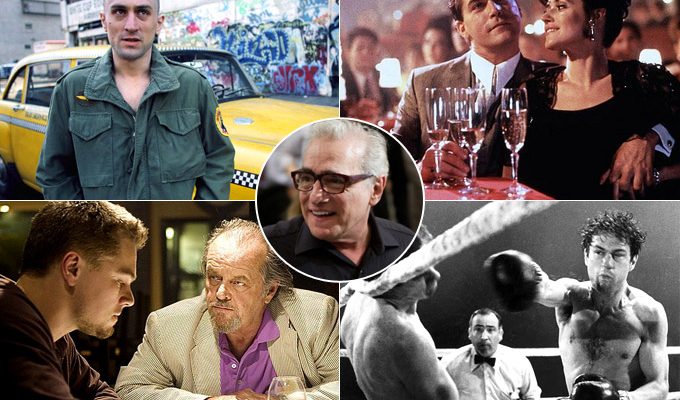“Cape Fear” (1991)
Looking back, it’s kind of shocking that Scorsese, following the critical and commercial groundswell surrounding his virtuoso mob masterpiece “Goodfellas,” would follow it up with “Cape Fear,” a shlocky, B-grade chiller featuring frequent collaborator Robert De Niro at his all-time campiest (and sinewiest). Ostensibly a remake of the 1962 suspense film (original stars Gregory Peck, Robert Mitchum and Martin Balsam all make appearances here), Steven Spielberg was originally attached to direct but at the last minute swapped projects with Scorsese (who awarded him “Schindler’s List” instead), citing “Cape Fear”‘s extreme violence, which Spielberg felt uncomfortable with. What we get is an elegant, gore-soaked pastiche that incorporates not only the original film (with the Bernard Hermann score lovingly reproduced by Elmer Bernstein) but elements from Alfred Hitchcock thrillers (complete with Saul Bass credit sequence), seventies exploitation movies (the Illeana Douglas rape sequence is blood-chilling) and, of course “Night of the Hunter” (De Niro is similarly tattooed). Although the movie runs slightly too long (the prolonged, hurricane-ravaged finale is overcooked to the point of limpness), it’s at times one of the more exhilarating Scorsese experiences—a movie that knows exactly what it is and is having a blast with it. (It is also the inspiration for one of the best-ever episodes of “The Simpsons.”) Anchored by fine performances (Nick Nolte was nominated for an Oscar, as was De Niro), breathtaking cinematography (and exemplary, subtle work by Industrial Light & Magic) and a willingness to gleefully sail over-the-top, “Cape Fear” is, first and foremost, pretty much fearless. [B]
 “The Age Of Innocence” (1993)
“The Age Of Innocence” (1993)
A film we should confess we weren’t overly enamored of when we first saw it, a recent rewatch of “The Age of Innocence” has led us to at least a partial reappraisal. It is, as we had remembered, sumptuously beautiful and if some of the principals feel miscast, it doesn’t stop them from turning in individually impressive performances, especially in Michelle Pfeiffer’s case. And the settings and supporting cast, including Joanne Woodward’s drily ironic reading of swathes of the source Edith Wharton prose, are all deliciously on-point as the rarefied world of upper class 1870s New York gradually closes in on poor, lovestruck but noble Newland Archer (Daniel Day-Lewis). But still, a certain narrative thinness makes itself felt—the film feels stretched out unnecessarily and, for a world with so many secrets and trapdoors, strangely lacking in subtext. And without those layers, Pfeiffer, Winona Ryder as May Welland and Day-Lewis seem rather exposed, having to manufacture emotional engagement where none springs up naturally. In fact, Day-Lewis’ Archer, if anything, is so distant as to not really register with us at all, and his illicit passion for Pfeiffer’s Ellen too often communicated repetitiously by him hissing some new entreaty or assignation at her from behind a curtain or a doorway. But elements of Scorsese’s filmmaking enthusiasm do find their way through: he plays with iris-ins and wipes and vignetting the edge of the frame at times to give it a kind of classic, almost silent-movie feel, and special mention should go to Saul and Elaine Bass’ credit sequence, which, set against a lace-overlaid backdrop of time-lapse flowers bursting into bloom, manages to be exactly as lushly romantic and yet arch as Wharton’s original book. It’s a line the film in general walks only unsteadily, but if the result is neither as broad nor as deep as Scorsese at his best, there is still a great deal to enjoy here, just don’t expect to be fully enraptured by the romance or fully tickled by the social satire. [B-]
“A Personal Journey Through American Movies with Martin Scorsese” (1995)
There are few, if any, others we’d rather hear talk at length about cinema than Scorsese. And ‘Personal Journey’ is just the ticket for those wanting a detailed glimpse into the man’s influences as he lays down, in a breezy 225 minutes, his own cinematic canon of what’s meant the most to him from America (it’s all there in the title). The beauty here is in the simplicity of the endeavor: featuring Scorsese talking to the camera along with clips of the films (some 70+ titles) he discusses the format is not at all revolutionary. But it doesn’t need to be when you’ve got Scorsese’s knowledge and passion guiding you. The film is broken down into four parts examining various director types: director as storyteller, director as illusionist, director as smuggler, and the director as iconoclast. This structure allows for a journey that bounces from one film to the next, not beholden to chronology but instead tracing influences and thematic resonances from one work to the next, and seeing how they connect. It’s so all-encompassing yet never overwhelming, and it gives one the feeling that Scorsese is our most gifted film professor, one we’d gladly listen to for twice the run time. Never didactic or snobbish, instead Scorsese is doing what’s become the standard in modern film criticism: he accepts that we’ve all had our own experience with movies through our lives, so he can only speak to that experience of his own, but he can do so with candor, passion, respect and irreverence. This may very well be the template for all the Ain’t it Cools, Slashfilms and, yes, The Playlists of the world. [A]

